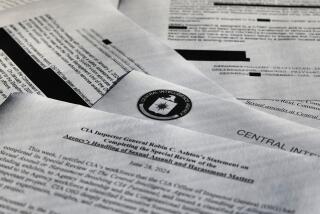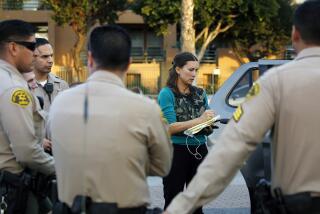Ex-CIA Aide Testifies Westmoreland Doctored Figures
- Share via
NEW YORK — Three months after the opening of Gen. William C. Westmoreland’s $120-million libel trial against CBS, the network Thursday produced its first evidence seeking to directly link the general with efforts to reduce estimates of enemy troop strength in Vietnam.
The assertion that Westmoreland doctored figures on enemy troops came from former CIA analyst Sam Adams, a co-defendant in the suit, and a key figure in the 1982 documentary, “The Uncounted Enemy: A Vietnam Deception.”
During a 1967 conference at CIA headquarters at Langley, Va., Adams testified Thursday, Westmoreland sent a cable outlining the “command position” for dropping thousands of enemy self-defense forces from the official estimates of enemy troop strength.
It was the first time, Adams said, that the position had been “put in concrete out of highest authority.”
Earlier, the jury hearing the case was shown an “outtake” of an Adams interview--a portion of the interview that was never broadcast--with CBS correspondent Mike Wallace during the production of the controversial documentary.
In it, Wallace asked Adams who had “slapped a ceiling” on “the number of enemy troops that we would acknowledge.”
“I didn’t know at the time,” Adams said. “I have since learned that Gen. Westmoreland had . . . slapped a ceiling on the order of battle. Now somebody might have told him to do it. I don’t know.”
The documentary which triggered Westmoreland’s libel action sought to show that he conspired to hold down enemy troop estimates to give a better picture of the United States’ progress in the guerrilla war.
Westmoreland was commander of U.S. troops at the time of the controversy but he had been in retirement for years when the CBS program was produced.
Adams, who was a CBS consultant on the production, maintained in his testimony, as he has for years, that the disagreement over enemy troop estimates was far more than a bureaucratic squabble between the CIA and the military services over methodology. The official military numbers, he said, were “a monument of deceit.”
Irregular Forces
By the end of 1966, after his first visits to Vietnam, he said he had concluded that all of the categories of irregular forces opposing U.S. forces and their allies, the South Vietnamese army, added up to a huge force. “There were probably something like 300,000, three times the order of battle (estimate) of 100,000,” he said.
Adams testified that he began in 1966 to find huge discrepancies between the military command’s estimates of guerrilla forces and those available from lower ranking U.S. officers, South Vietnamese officials and captured enemy documents.
In some provinces, he said, captured documents showed self-defense forces and secret self-defense forces to be 11 or 12 times the official estimate of Westmoreland’s headquarters.
In the interview shown to the jury, Adams said Col. Gains Hawkins, the officer in charge of following the enemy order of battle in Westmoreland’s headquarters, privately agreed that the military’s enemy estimates were far too low but continued to defend them in crucial conferences.
During a break in one of the meetings in Saigon in September, 1967, Adams said Hawkins told him, “I want you to know the command position is that there are 65,000 (guerrillas), but I believe there are 120,000.”
But, Adams added, “what really blew my mind” was a note left for each participant in the conference before one session.
“What the piece of paper said was . . . if the CIA will agree to drop the self-defense militia, the . . . command in Saigon will add 15,000 guerrillas to their estimate.”
Adams said he showed the note to George Carver, the CIA director’s special assistant for Vietnamese affairs, and was told to “keep up the good fight” for counting the self-defense forces.
But when he got back to Washington, he said, he was shown a memo. “And it was a memo written by George Carver, dated 18 Sept. 1967,” Adams said. “That is a couple of days after I’d left Saigon, and I discovered that not only had we bought off only lowered numbers, but another category, the political cadres, had disappeared from the estimate.”
At the end of November, Adams said he was shown a memorandum from another CIA officer forecasting that the Viet Cong forces were preparing to launch an enormous offensive.
When he was asked to comment on it, he said he replied in mid-December, “OK, maybe there is a big offensive coming, but the one thing that we have to worry about is that there are twice as many of ‘em out there as we have been saying all along, and . . . if they’re coming with an offensive, it’s going to be twice as big an offensive as we give them credit for.”
The countrywide Tet offensive, a turning point in the war, came at the end of January.
Adams told the jury he resigned from his job on the staff of the special assistant for Vietnam affairs at the CIA the next day, and that he told Carver his main reason was that the CIA had “caved in” to the military command in Saigon on the issue of enemy troop strength.
Attorneys for Gen. Westmoreland are expected to get their chance to cross-examine Adams next week.
More to Read
Sign up for Essential California
The most important California stories and recommendations in your inbox every morning.
You may occasionally receive promotional content from the Los Angeles Times.













